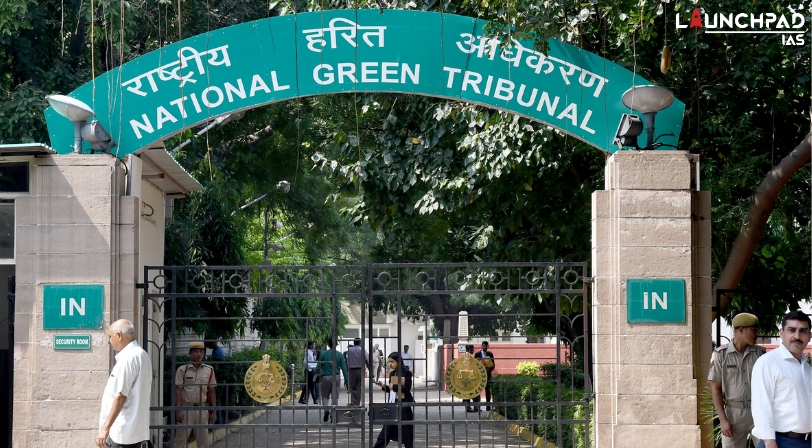Introduction
- The National Green Tribunal Act established the NGT in 2010.
- It is a specialized environmental court that deals with cases relating to environmental protection and the conservation of forests
- It has judicial powers that allow it to exclusively decide on civil environmental matters.
- The tribunal follows principles of natural justice and is not bound by the mainstream code of civil procedure.
Importance of NGT
- India is one of only a few countries to have a specialized environmental court system.
- The advantage of such a system is that it permits direct access to environmental justice
- NGT allows for more relevant and greater expertise, sets up alternative dispute resolution mechanisms and offers a path for the evolution of environmental jurisprudence.
- The track record of the still-young NGT suggests that effort can produce results
- Today, industry and environment regulators fear that NGT might take action if it hears a case.
- It provided a new dimension to environment adjudication by curtailing delays and imparting objectivity.
- To achieve the objective of Articles 21, 47 and 51A (g) of the Constitution of India is using fair, fast and satisfactory judicial procedure.
- Reduce the pressure and burden on the High Courts and Supreme Court
Criticism
- Disadvantages are that it possibly takes away from mainstream jurisdictions and transfers to and from the mainstream courts could become complicated.
- Like the recent event on Yamuna floodplains, this saw rampant clearing of the vegetation cover and construction. But NGT instead of taking stringent action just imposed a fine for the event and could do little to prevent the spoiling of this fragile ecosystem.
- NGT denies access to justice through two means: firstly, by imposing a limitation period, and secondly, by situating itself only in big cities spread across India.
- A green tribunal should have been based in a place that has the highest forest cover or large mineral deposit.
- For a tribal trying to stop pollution from an iron ore mine in Bastar, this means filing and fighting a case in Bhopal. This is neither easy nor affordable.
- Critics have accused the NGT of overstepping its jurisdiction and taking actions for which the NGT Act has not empowered it.
- NGT’s critics have also questioned the “lack of environmental finesse” of its expert members. “Usually, the expert members are experts of one particular field and not of the environment as a whole.
- For instance, an expert member who has been working on forests for many years would not be able to comprehend the issues arising out of industrial pollution.
- Conflicts are brewing between NGT and the high courts. As per the NGT Act, appeals from NGT can only go to the Supreme Court, thus bypassing the high courts.
- The backlog of cases in NGT is another reason for the institution’s failure to address environmental matters.
- Despite the prompt steps taken by them, there has been little change in the ever-rising pollution levels.
Recent Judgements
- The NGT’s notice to the states on effective implementation of the Biological Diversity Act is timely
- A committee of experts, appointed by NGT to assess the damage caused to the Yamuna floodplain in Delhi where the World Culture Festival was held, has found that the event has extensively damaged the Yamuna floodplain.
- In a landmark judgement, the Kochi circuit bench of the NGT banned all diesel vehicles more than 10 years old from operating in six cities in Kerala
- This follows a similar decision made for diesel cars in the Delhi region. There are expectations to extend this to 15 major Indian cities with the worst air quality levels.
- The NGT has also issued various prohibitory orders against sand mining in riverbeds conducted without environmental clearance.
- It has imposed a no-construction zone of 75 metres around lakes and Rajakaluves (stormwater drains) in Bengaluru.
- Cancellation of coal block clearance in Hasdee-Arand forests overriding central government’s decision
- The NGT has directed the Centre and Delhi government to provide alternative modes of cremation of human remains, saying the traditional method of burning wood emitted hazardous pollutants into the environment.
- NGT held that open spaces, recreational grounds and adequate parking facilities in buildings had an important bearing on the right to life of people.
- The NGT has prohibited the use of plastic carry bags in various areas of Punjab and Haryana
- The NGT banned mining or removal of sand from river beds across the country without a licence and Environmental Clearance from the Union Ministry of Environment and Forests.
- In a landmark order passed on April 17 2015, the tribunal issued an interim ban on rat-hole coal mining and transportation of the mineral in the Meghalaya.
Need for further Reforms
- We must strengthen it by giving it more powers and by investing in strengthening its infrastructure
- Judicial review is an important power that must be given to NGT
- We should include other environment-related laws within NGT’s ambit.
- NGT also needs to put certain systems in place for transparent decision-making.
- NGT needs to establish principles and criteria to estimate fines, damages and compensation.
- It should also identify institutions and experts who can help it scientifically estimate environmental damages/compensation/fines on a case-to-case basis.
- NGT must put internal checks and balances for efficient and transparent delivery of justice.
- Suomotu jurisdiction has to be an integral feature of NGT for better and more effective functioning.
- There is a need for the central and state governments to work in collaboration with the NGT for an effective outcome.
Also checkout : Rhythu Bandhu Scheme: https://launchpadeducation.in/rythu-bandhu-scheme-telangana/


